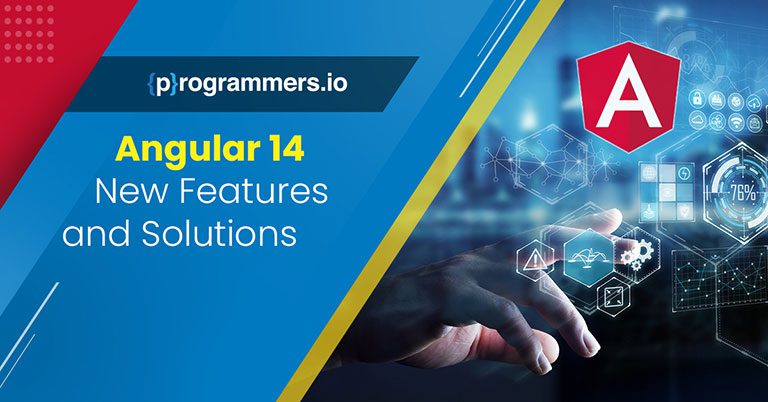Studying the New Features and Solutions in Angular 14
AngularJS has taken the world of JavaScript libraries and solutions by storm. The popular framework has soared in popularity during the last couple of years and has become one of the most prominent full-stack JavaScript frameworks around us today. Angular JS is more than just a JavaScript framework and comes with a library for developing single-page applications and heavy web apps.
Angular 14 is the latest entrant in the Angular frameworks series and was released in June of 2022. The release was welcomed with open arms in the industry and saw many developers and organizations work tirelessly to incorporate the changes.
Angular 14 introduces a number of new features and facilities within its new facility. The latest version comes with new templates, default components, and the most significant name change that we have to date. Angular will now be known as Angular 2.0, henceforth, with new interactive developments.
In this article, we take a look at the new features and solutions present within Angular 14. We also study some of the latest changes and how they will impact your workflow as a developer.
Everything New in Angular 2.0
Typed Forms
The newest update in the framework allows users to now use TypeScript for enforcing strict form types inside their forms. This new update means that each new field within the app will be checked in line with the app you have before the form is submitted forward.
The new updates in the strictly typed forms will lead to the following results:
- A better look and feel with a better interface.
- The form is itself a lot easier to use for all users, with minimum confusion.
- There are a limited number of validation errors on the screen.
Standalone Components
The reusable component feature is made better in the new Angular 2.0, Developers now get the feasibility of building components right within the framework. The components used within TypeScript and Angular can be great for branding new interfaces and creating new ones.
Standalone component is a standout technology addition, as it gives you the ability to create your own components, and then implement them anywhere you want within the application. The standalone components can be easier to implement and even easier to integrate within the solution.
Angular CLI Auto Completion
The auto completion mode within Angular 2.0 can be perfect for integrating new code, and utilizing old one. The auto-completion mode comes in handy for command line interface or CLI commands. The completion feature utilizes the TypeScript file and works on an IntelliJ IDEA Plugin for best results.
All users can incorporate this feature by adding angular to their list of codes. Developers can also select the kind of completion process they want for their code. The auto-completion procedure can help you type command line instructions without fail and enter the command within the ECMAScript. The auto-completion feature can also auto turn on the tab completion window when you are running your application. This can come in handy for developers without much experience in Angular.
With the smoother learning curve, developers can get used to the system, and interact with it for the best results possible.
Improved Diagnostics
Angular 2.0 comes with improved methods for debugging templates and syntax errors. The new framework release reduces the syntax errors within the system, leading to improved results overall. The ng-template-error can help print the code in context without running any error message.
All users get an option to enable the code through a simple code message. The Angular team has also started progress on improving code error messages and making sure that they are more helpful and concise in nature. The code messages can ensure that you are able to easily debug your templates through the DevTools. The additional output decorator can also provide support for custom objects.
Streamlined Accessibility for Page Title
The page title you view on your page is the most important piece of information present on a web page. The streamlined page title is also what users get to see when they open a new page tab. The page title is also the information used by search engines when they are referencing or indexing a page.
Angular 2.0 gives you the unique ability to customize your title tags. The customization processes can start from the head of your title page to the HTML context added to the title tag.
Latest Features within Angular CDK
The Angular CDK also comes with new features as part of the package. The Angular library provides a set of primitives for the services, building components, and some of the other types of applications present inside the application.
The latest Angular 2.0 update comes with additions to Angular CDK as well. These features translate into benefits along the following lines;
- Better FormBuilder: The Angular form builder comes with excellent features that allow you to create your applications with ease. The forms you create can now be implemented through simple expressions instead of separate controllers for different form fields.
- Angular Elements; Angular Elements is a new way to build HTML elements. The new feature allows APIs in Web Components and V8 as well.
The new Angular CDK also promises a number of new primitives as well. The primitives can help in writing code directly. It can also help create link tags that can be used in directives and templates.
Angular 2.0 offers great news for the development fraternity as a whole. The solution provides a consistent tooling experience and API for developers. You can enjoy the features by upgrading to Angular 14.
How can we help you?
We have hundreds of highly-qualified, experienced experts working in 70+ technologies.









